Asymptomatic Stones: Remove Each Piece? Or Leave in Peace?
Benjamin K. Canales, MD, MPH discusses the prevalence and natural history of asymptomatic kidney stones, emphasizing that while these stones may not initially cause symptoms, they have the potential to lead to significant complications, including pain, infection, and obstruction. He identifies various factors that influence the decision-making process, such as stone size, location, composition, and patient-specific factors including age, comorbidities, and risk of future stone-related events.
Dr. Canales discusses the current guidelines and evidence-based practices for managing asymptomatic stones, including the benefits and risks associated with both intervention and observation. He highlights the criteria for selecting patients who may benefit from proactive treatment, such as those with high-risk anatomical features or a history of recurrent stones, and scenarios where a conservative approach, involving regular monitoring and preventive measures, may be more appropriate.
Technological advancements and surgical techniques have improved the safety and efficacy of stone removal procedures. Dr. Canales reviews minimally invasive options, such as ureteroscopy and percutaneous nephrolithotomy, and their role in the management of asymptomatic stones. The presentation includes a discussion on the potential complications of these procedures and the importance of patient counseling to set realistic expectations.
Read More




